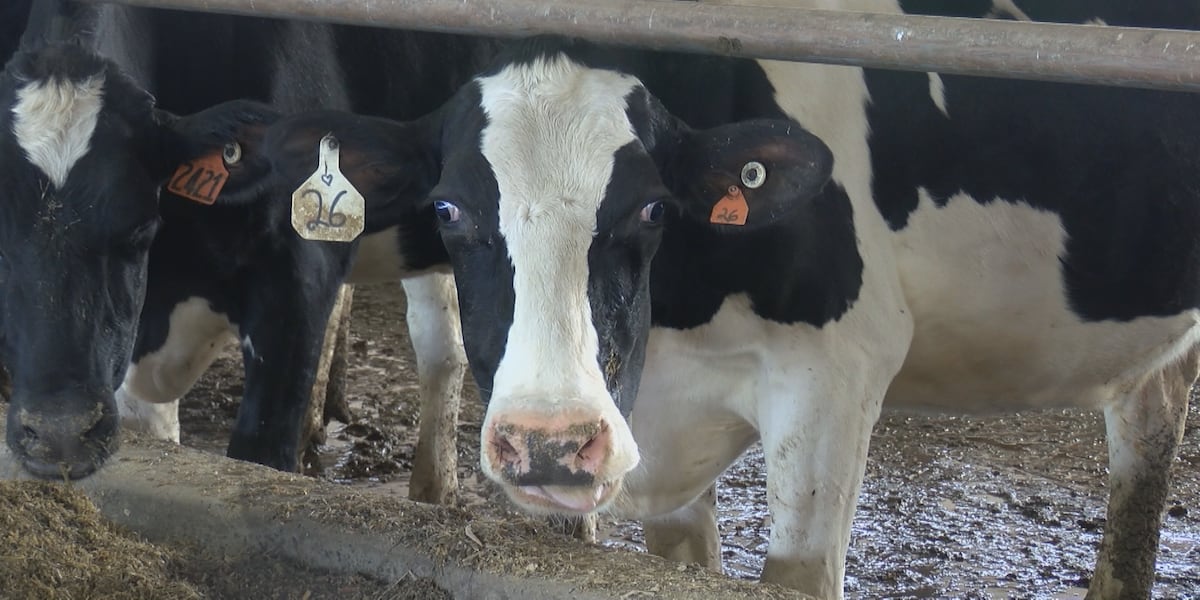UVM researchers developing system to turn cow manure into propane – WCAX

Report on Innovative Waste-to-Energy Technology and its Contribution to Sustainable Development Goals
Project Overview: Propane Production from Dairy Waste
Researchers at the University of Vermont, in partnership with the University of Wisconsin-Madison and with funding from the U.S. Department of Agriculture, are developing an innovative technology to convert dairy farm manure into propane. This initiative presents a sustainable alternative to current anaerobic digesters, which primarily produce methane, a potent greenhouse gas. The project, initiated in 2022, utilizes a photo reactor to interrupt the standard digestion process, redirecting biological intermediates toward the creation of a cleaner-burning and more easily transportable fuel.
Alignment with United Nations Sustainable Development Goals (SDGs)
The research project directly addresses several key Sustainable Development Goals through its focus on renewable energy, climate action, and sustainable agriculture.
SDG 7: Affordable and Clean Energy
The project is a direct contribution to ensuring access to affordable, reliable, and sustainable energy.
- It develops a process to generate a cleaner-burning fuel (propane) from a renewable, localized source (animal manure).
- The technology aims to empower remote agricultural communities by providing an on-site energy source, reducing reliance on external fuel supplies.
SDG 13: Climate Action
A primary driver for the project is the urgent need to combat climate change and its impacts by reducing greenhouse gas emissions.
- The technology is designed to mitigate the production of methane, a greenhouse gas significantly more potent than carbon dioxide, from agricultural operations.
- By creating propane, which has a reduced environmental footprint, the process offers a direct pathway to lowering the carbon intensity of the agricultural sector.
SDG 9: Industry, Innovation, and Infrastructure
This research exemplifies the promotion of sustainable industrialization and fostering innovation.
- It represents a significant scientific innovation in waste management and biofuel production.
- The ultimate vision is to develop resilient, scalable infrastructure that can be rolled out to farms, transforming waste streams into valuable assets.
SDG 12: Responsible Consumption and Production
The project embodies the principles of a circular economy and sustainable resource management.
- It redefines agricultural waste, specifically the 22,000 kilograms of manure an average dairy cow produces annually, from a source of pollution into a valuable input for energy production.
- This ensures sustainable production patterns within the agricultural industry by closing the loop on waste.
Future Outlook and Economic Implications
The research team aims to complete the initial project phase by the spring, with a long-term vision of creating a commercially viable version for farm implementation. The successful deployment of this technology would not only advance environmental goals but also provide economic benefits to farmers. The “dream,” as stated by researcher Matt Scarborough, is for farmers to produce enough propane for their own operational needs and generate additional income by selling the surplus, thereby strengthening rural economies and contributing to SDG 2 (Zero Hunger) by improving the financial stability of food producers.
Analysis of Sustainable Development Goals in the Article
1. Which SDGs are addressed or connected to the issues highlighted in the article?
-
SDG 7: Affordable and Clean Energy
- The article focuses on developing a new technology to create a “cleaner-burning fuel” (propane) from dairy farm waste. This directly aligns with the goal of promoting clean and renewable energy sources.
-
SDG 9: Industry, Innovation, and Infrastructure
- The research conducted by the University of Vermont represents an innovation in industrial processes for the agricultural sector. The project aims to create new, sustainable infrastructure (“photo reactor”) to retrofit farms and make them more environmentally sound.
-
SDG 12: Responsible Consumption and Production
- The core of the project is the sustainable management of waste. It addresses the issue of cow manure, which can be a “source of a lot of pollution,” by transforming it into a valuable resource, thereby promoting a circular economy model in agriculture.
-
SDG 13: Climate Action
- A primary motivation for the research is to create an alternative to methane production. The article explicitly states that “methane is a potent greenhouse gas,” and the new technology aims for a “reduced environmental footprint,” directly contributing to climate change mitigation.
-
SDG 2: Zero Hunger
- By creating a technology that can “help farmers in this country” and provide them with an additional source of revenue (“have extra to sell”), the project supports the economic viability and sustainability of agricultural systems, which are fundamental to food security.
2. What specific targets under those SDGs can be identified based on the article’s content?
-
Target 7.2: Increase substantially the share of renewable energy in the global energy mix.
- The project’s goal is to produce propane, a fuel, from a renewable source (cow manure). The article mentions that about 15 Vermont farms already use manure to generate “renewable natural gas,” and this new technology offers a cleaner alternative, further contributing to the share of renewable energy.
-
Target 9.4: Upgrade infrastructure and retrofit industries to make them sustainable, with increased resource-use efficiency and greater adoption of clean and environmentally sound technologies.
- The development of a “photo reactor” that interrupts an anaerobic digester’s process is a direct example of creating a clean and environmentally sound technology to upgrade agricultural infrastructure. The aim is to “roll out to farms,” indicating a plan for wider adoption.
-
Target 12.5: Substantially reduce waste generation through prevention, reduction, recycling and reuse.
- The technology is designed to recycle and reuse “dairy farm waste.” The article quantifies this waste by stating, “An average dairy cow can produce about 22,000 kilograms of manure a year,” highlighting the scale of waste that this technology can repurpose.
-
Target 13.3: Improve education, awareness-raising and human and institutional capacity on climate change mitigation.
- The project, involving researchers at the University of Vermont and the University of Wisconsin-Madison, demonstrates an increase in institutional capacity to develop solutions for climate change mitigation. The article itself serves to raise awareness about the environmental impact of methane and innovative solutions.
-
Target 2.4: Ensure sustainable food production systems and implement resilient agricultural practices.
- The technology makes dairy farming more sustainable by managing its waste and reducing its environmental footprint. It also enhances the resilience of farms by providing an on-site fuel source and a potential new product to sell, as expressed in the “dream” that farmers could “have extra to sell.”
3. Are there any indicators mentioned or implied in the article that can be used to measure progress towards the identified targets?
-
Indicator for Target 7.2 (Renewable energy share):
- The article implies progress can be measured by the amount of propane produced from manure. The vision of farmers using it “around their farm” and having “extra to sell” suggests that the volume of this new renewable fuel entering the energy mix is a key metric.
-
Indicator for Target 9.4 (Adoption of clean technologies):
- An implied indicator is the number of farms that adopt the new photo reactor technology. The team’s hope to “create a version to roll out to farms” points to the adoption rate as a measure of success.
-
Indicator for Target 12.5 (Waste reduction):
- The article implies an indicator related to the volume of manure processed or recycled. By stating that a cow produces “22,000 kilograms of manure a year,” it provides a baseline to measure the amount of waste being diverted from becoming a “source of a lot of pollution.”
-
Indicator for Target 13.3 (Climate action):
- A key implied indicator is the reduction in greenhouse gas emissions compared to current systems. The article’s focus on replacing methane, a “potent greenhouse gas,” with a fuel having a “reduced environmental footprint” suggests that the net change in emissions is the critical measure of climate impact.
-
Indicator for Target 2.4 (Sustainable agriculture):
- The article suggests progress can be measured by the additional income generated for farmers from selling surplus propane. The statement, “And hopefully have extra to sell. So, that is the dream,” points to the economic benefit for farmers as a crucial indicator of creating more resilient agricultural systems.
4. Summary Table of SDGs, Targets, and Indicators
| SDGs | Targets | Indicators (Implied from the Article) |
|---|---|---|
| SDG 7: Affordable and Clean Energy | 7.2: Increase substantially the share of renewable energy in the global energy mix. | Volume of propane produced from manure, contributing to the renewable energy supply for farms and the market. |
| SDG 9: Industry, Innovation, and Infrastructure | 9.4: Upgrade infrastructure and retrofit industries to make them sustainable… with greater adoption of clean and environmentally sound technologies. | Number of farms adopting the new photo reactor technology. |
| SDG 12: Responsible Consumption and Production | 12.5: Substantially reduce waste generation through prevention, reduction, recycling and reuse. | Total volume of cow manure processed and recycled into fuel, preventing it from becoming a pollutant. |
| SDG 13: Climate Action | 13.3: Improve education, awareness-raising and human and institutional capacity on climate change mitigation. | Net reduction in greenhouse gas emissions by producing propane instead of methane from manure. |
| SDG 2: Zero Hunger | 2.4: Ensure sustainable food production systems and implement resilient agricultural practices. | Additional income generated for farmers from selling surplus propane, enhancing farm economic viability. |
Source: wcax.com
What is Your Reaction?
 Like
0
Like
0
 Dislike
0
Dislike
0
 Love
0
Love
0
 Funny
0
Funny
0
 Angry
0
Angry
0
 Sad
0
Sad
0
 Wow
0
Wow
0















































/environment-climate-change-and-health-(ech)/water-sanitation-hygiene-and-health-(wsh)/landfill-tuvalu-36092.tmb-1200v.jpg?sfvrsn=5c21fe40_1#)


.jpg.webp?itok=0ZsAnae9#)


























